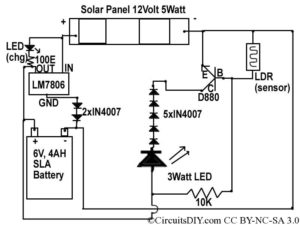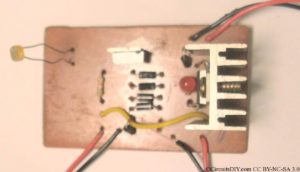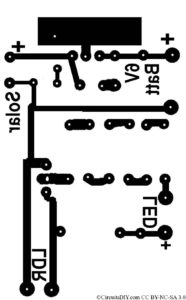Today we discuss about a simple solar LED circuit. We know that solar panels comes from 12Volt 3watt to larger sizes. So, for storing energy, we need a 12Volt battery. As we don’t want ‘jhamela’, we prefer SLA SMF batteries.
12Volt SMF batteries comes around 650-700 rupees, while 6Volt SMF batteries comes in 150-200 rupees, commonly known as charger battery. These have 4AH rating at 6Volt. That’s of the source and storage, now we think about the output. Yes, we will be using a LED of high leumens of course. 1Watt or 3Watt LED requires 3.5-4Volt forward voltage to glow at full intensity. We also need to provide a way that the circuit senses light and turns on the LED whenever there is darkness(night).
So, finally we have to make a circuit which does the following,
- 12Volt solar to 6Volt battery charging. @5Watt
- 6Volt battery to 4Volt LED driving @3Watt
- Sense automatically darkness and switch on the LED.
This below circuit does above all steps in a simple manner of voltage regulation. If we have used voltage conversion technology, it would be more efficient but that would increase circuit’s complexity and cost. So, the circuit diagram below.
In the diagram, we can see 12Volt supply from solar panel(5Watt) is regulated by LM7806 I/C to charge 6Volt battery. Since 6Volt batteries charge at 7.2-7.5Volt, we added two forward biased IN4007 diode to reference level, so that the pair makes a zener breakdown at 1.2Volts, making the output at 7.2Volts. That voltage charges battery at maximum 5/12=400ma(appx) which is a good current level, as it is exactly C/10 of that of battery. So, this will never overcharge the battery.
N.B: Add a heatsink to the LM7806 IC.
Now we come to LED driving unit. Here, we use same logic of forward biased diode to reduce voltage. The battery voltage of 6Volt SMF battery is around 6.4-6.6Volts. Here we attach 5 forward biased IN4007 diode to reduce voltage by appx 3Volt, so the LED is fed with around 3.5Volts. If we require more brightness, we will short any one of the diodes to increase the voltage by 0.6Volt. The driver transistor here used is D880, we have used it in many circuits, as it is a easily available NPN transistor with high current ratings. We bias the base through a 10K resistor from the +6V rail, and reverse bias it through a LDR to GND. Thus, when there is light on LDR, the transistor will be unsaturated, and vice versa. The total parts expense in this circuit is 30-35 rupees. We can also make a PCB instead of making it on vero.


Hello Arup Da,
Kemon Acho.
I have a very big pbrlm,
is Connecting a battery of higher Ah means more backup for leds.?
What is the Formula by which we can Calculate Operating time if we Connect 24 5mm white LED 3.6V and 20mA to a 6V 4.5 Ah battery by reducing its voltage to 3.6 v using 4 Diodes...??
Please Help...
Hi i would like to develop a device that should monitor and control the charging of a lead acid battery from a photovoltaic panel and its discharging. The device should also control automatically an emergency light in case the ambient luminance falls below certain level.
The minimum specifications are:
1.A controller should charge automatically a 7Ah lead acid battery from a photovoltaic panel until fully charged. The battery should not get overcharged.
2.There should be provision for automatic initiation of the charging mode when the emergency light is ‘on’ even if the battery is still not fully discharged.
3.The photovoltaic panels should be protected against reverse currents from the battery or the load.
4.There should be a linear, ten level battery output voltage monitor with a range between 10 and 15 volts.
5.The device should operate from 220 V, AC power source.
6.The primary circuit of the power transformer should be fuse protected.
7.Yellow LED should indicate “charging” mode of the controller.
8.Green LED should indicate “charged” mode of the controller.
9.Red LED should indicate “low battery” state, when the voltage of the battery is below 10.5V.
10.Green LED should indicate “power on” of the device.
11.Power switch for the device.
12.An emergency light controller should operate a relay driven emergency light for ambient luminance below 20 lux.
13.The device should have 220V output for supplying an emergency light with Pmax=100W
Can you please tell me how i can build it